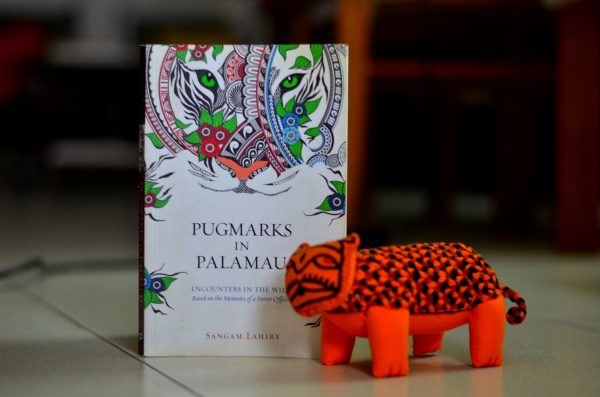Tigers are forever in the news
Review of ‘Pugmarks in Palamau’
If you’re searching for statistics on tigers, environment, ecosystem, and other issues that concern wildlife, this book doesn’t even pretend to lead you to them. But if it is heart-warming stories on wildlife and memoirs based on some real-time encounters in the wild, reading ‘Pugmarks in Palamau’ by Sangam Lahiri is going to give hours of thrill. It simple line drawings done with intuitive charm is what makes you thank the almighty for creating books, then this is one that has many. Yes, I loved the illustrations by Suhita Mitra as much as I loved the explanations and story-telling in words that are far from being pretentious of a literary lineage.
The best part about the book is that you do not necessarily have to go from one page to another or from one chapter to another because every chapter is like another thrilling story that opens up at least one new magical facet about the forest. As I read on I was mesmerized by the experiences of this forest officer and literally chided myself for not having thought of appearing for the IFS examination when I was at an age when I could have. Even I could then possibly have gone deep into forests wondering at the food habits of the tigers of Betla, or could have had the opportunity to watch the release of a python into the wild, or have been atop a machchan observing wild animals during a lunar eclipse, or even cried when the life of a bold tuskar ended. Well, these are just a few of the glimpses that the book is all about… and let me admit here that there are chapters that I have read twice and even thrice and not because one reading was not enough to understand but because I wanted to relive those experiences in my imagination.
One of the chapters is on the imprinting behaviour of the tigers of Betla and the author tells us that the term was ‘coined by Lorenz, in 1935, to denote a certain learning process belonging to the realm of social behaviour. But Immelmann and Meves used it in 1973 to denote irreversible behaviour in animals.’ Imprinting is all about the tiger mother teaching her cubs ‘how to catch and what to catch’ and this is so much like what humans do. The chapter reads like a thriller when we realise how the tigers in Betla began killing cattle in human occupied areas with degraded forests. The villagers soon realised this habit and started poisoning cattle in a bid to kill the tigers and their cubs that were becoming a perceived menace. The Project tiger officials ‘began burying the killed cattle on the second day… and burying continued whenever the kill was located, thus the cubs perhaps learnt not to return to the kill.’ It was learning through imprinting that saved the cubs from certain death.
The book does have these interesting tales of life in the forest and the reader jumps from chapters talking about a picnic in the wild to encounters with extremists. There are lessons in forest development and eco-development in the form of real stories and the book never lets you think you reading some sort of a dull and impassive text-book.
By the time I finished reading this book I was not only in love with Palamau and the forest reserves surrounding it, but was full of the sort of adventures that are possible in a reserve. The chapters add to this sense of adventure and you’ll agree with me when I quote a few starting lines in the chapters. One chapter where samhars were to be released from captivity has ‘It was a biting cold night…’ as the starting line. Another on panthers begins with a line that can give anyone an adrenalin rush: ‘The panthers and leopards of Palamau, and more specifically of Betla, are notorious for their habit of stealing small cattle under the very noses of cow herders or from village hamlets…’
And so one goes from sambhars to cheetals to leopards to panthers to tigers and even to pythons and elephants and the stories just go on and on… until one is firmly hypnotised by not just the fauna but also the way the flora gets mentioned.
This book is all about the encounters in the wild and based on the memoirs of a forest officer urging us all to ‘take pride in our common, natural heritage while encouraging us to participate in the conservation of what remains of the earth’s rich biodiversity and wildlife’. I loved reading the book.
.
Book details:
Title: Pugmarks in Palamau
Author: Sangam Lahiri
Publisher: Leadstart
ISBN: 978-93-81115-64-0
Price: Rs 249 (in 2016)
.
.
.
Buy this book here:
Amazon: Pugmarks In Palamau
.
.
Arvind Passey
27 July 2016









